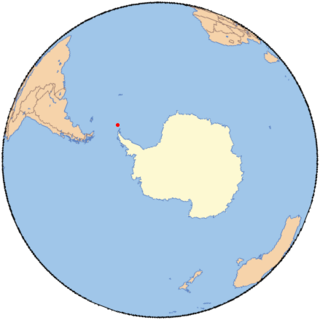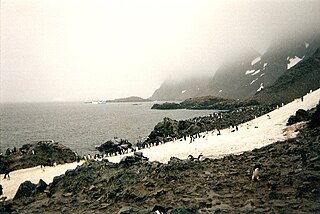
The South Orkney Islands are a group of islands in the Southern Ocean, about 604 kilometres (375 mi) north-east of the tip of the Antarctic Peninsula and 844 kilometres (524 mi) south-west of South Georgia Island. They have a total area of about 620 square kilometres (240 sq mi). The islands are claimed both by Britain, and by Argentina as part of Argentine Antarctica. Under the 1959 Antarctic Treaty, sovereignty claims are held in abeyance.

Etar Snowfield is a roughly crescent-shaped snowfield on western Livingston Island in the South Shetland Islands, Antarctica situated west of Urdoviza, Medven and Berkovitsa Glaciers, northwest of Verila Glacier, east of Ivanov Beach and south of Gerlovo Beach. It drains the west slopes of Oryahovo Heights and the north slopes of Rotch Dome, and flows into Barclay Bay between Mercury Bluff and Rowe Point. The feature extends 5 km (3 mi) inland, and 15 km (9 mi) in south-southwest to north-northeast direction.

Krichim Peak is an ice covered peak of elevation 500 m in Vidin Heights on Varna Peninsula, Livingston Island, an island in the South Shetland Islands, Antarctica. Surmounting Saedinenie Snowfield to the northwest and Panega Glacier to the southeast. The peak is named after the town of Krichim in Southern Bulgaria.

Medven Glacier is a 2.5 km long and 1.5 km wide glacier on Ioannes Paulus II Peninsula, Livingston Island in the South Shetland Islands, Antarctica situated east of Etar Snowfield, south of Urdoviza Glacier and north of Berkovitsa Glacier. It is bounded by the east slopes of Oryahovo Heights and drains eastwards into Prisoe Cove, Hero Bay between Remetalk Point and Agüero Point. Bulgarian mapping in 2005 and 2009.

Perunika Glacier is an 8 km long and 3 km wide (average) roughly crescent-shaped glacier in eastern Livingston Island in the South Shetland Islands, Antarctica situated east of Pimpirev Glacier, south of Saedinenie Snowfield, southwest of Kaliakra Glacier, west of Huron Glacier, and north of Balkan Snowfield and the head of Huntress Glacier.

Rose Valley Glacier is a glacier on Varna Peninsula, eastern Livingston Island in the South Shetland Islands, Antarctica situated northeast of Saedinenie Snowfield, northwest of Debelt Glacier and north of Panega Glacier. It extends 5.2 km in southeast-northwest direction and 3.7 km in southwest-northeast direction, and drains the northeast slopes of Vidin Heights to flow into Lister Cove and McFarlane Strait between Pomorie Point and Inott Point.

Tundzha Glacier is a glacier on Livingston Island in the South Shetland Islands, Antarctica situated east-southeast of Berkovitsa Glacier, west of Saedinenie Snowfield, northwest of Pimpirev Glacier, north of Kamchiya Glacier and east-northeast of Verila Glacier. It is bounded by Snow Peak to the west, Teres Ridge to the east and the glacial divide between the Drake Passage and Bransfield Strait to the south. The glacier extends 7.5 nautical miles in east-west direction and 2.4 nautical miles in the north-south direction, and drains northwards into Hero Bay between Avitohol Point and Siddins Point.

Verila Glacier on Livingston Island in the South Shetland Islands, Antarctica is situated southeast of southern Etar Snowfield, southwest of Berkovitsa and Tundzha Glaciers, and west of Kamchiya Glacier. It is bounded by Rotch Dome to the west, Casanovas Peak and Snow Peak to the north, and Ustra Peak to the southeast. The glacier is roughly crescent-shaped, extending 7 nautical miles in an east-west direction and 2 nautical miles in a north-south direction, and drains southwards into Walker Bay, Bransfield Strait between John Beach and Liverpool Beach at Hannah Point. The glacier's bedrock is connected to Kaliman Island in Walker Bay by a 600 m long moraine tombolo. The area was visited by 19th century British and American sealers.

Morton Strait is the 9 km (4.9 nmi)-long and 6.2 km (3.3 nmi)-wide strait between Snow Island on the southwest and Rugged Island and Livingston Island on the northeast, in the South Shetland Islands, Antarctica. The Aim Rocks and Long Rock lie in the strait.

.
Buchan Bay is a small bay between Cape Hartree and Cape Murdoch, near the southwest end of Laurie Island in the South Orkney Islands. It was charted in 1903 by the Scottish National Antarctic Expedition under William Speirs Bruce, who named it for Alexander Buchan, noted Scottish meteorologist.
Pirie Peninsula is a narrow peninsula extending 6 km (3.7 mi) northward from the center of Laurie Island, in the South Orkney Islands of Antarctica. The peninsula was surveyed in 1903 by the Scottish National Antarctic Expedition under Bruce, who named it for Dr Harvey Pirie, surgeon and geologist of the expedition.

Eillium Island is a small island 2.2 km (1.4 mi) north-west of Rumbo Punta, the north-west tip of Laurie Island in the South Orkney Islands of Antarctica. It was first seen and roughly charted by Captain George Powell and Captain Nathaniel Palmer during their joint cruise in 1821. It was recharted in 1903 by the Scottish National Antarctic Expedition under Dr. William S. Bruce, who named it for his son Eillium.

Cape Geddes is a cape which forms the northern end of the Ferguslie Peninsula on the north coast of Laurie Island, in the South Orkney Islands of Antarctica. It was charted in 1903 by the Scottish National Antarctic Expedition under William Speirs Bruce, who named it for Professor Patrick Geddes, a noted Scottish biologist and sociologist.
Point Moreno is a point at the east side of the entrance to the small cove at the head of Scotia Bay, on the south coast of Laurie Island in the South Orkney Islands. Charted in 1903 by the Scottish National Antarctic Expedition under Bruce, who named it for Francisco P. Moreno, noted Argentine scientist and director of the Museo de la Plata.
The Melville Highlands are an ice-covered upland rising to about 500 metres (1,600 ft) and forming the central part of Laurie Island between Pirie Peninsula and the south coast, in the South Orkney Islands off Antarctica. The name derives from James Weddell's map of 1825 whereon the name "Melville Island" appears for the already named Laurie Island; it was given for Robert Dundas, 2nd Viscount Melville, who was First Lord of the Admiralty, 1812–27 and 1828–30, including the period of Antarctic exploration by Weddell. To preserve the name in this area it was applied to these highlands by the UK Antarctic Place-Names Committee in 1987.
Marr Bay is a bay lying between Cape Valavielle and Fraser Point along the north coast of Laurie Island, in the South Orkney Islands off Antarctica. It was mapped in 1903 by the Scottish National Antarctic Expedition under William Speirs Bruce, and was named for James W.S. Marr, a member of the Discovery Committee zoological staff, by personnel on the Discovery II following their survey of the South Orkney Islands in 1933.
Macdougal Bay is a small bay lying between Ferguslie Peninsula and Watson Peninsula on the north coast of Laurie Island, in the South Orkney Islands, Antarctica. It was charted in 1903 by the Scottish National Antarctic Expedition under William Speirs Bruce, who named it for J. Macdougal, third mate of the expedition ship Scotia.
Mackintosh Cove is a cove immediately southeast of Fraser Point along the north coast of Laurie Island, in the South Orkney Islands, Antarctica. It was charted in 1903 by the Scottish National Antarctic Expedition under William S. Bruce, and was named for Neil A. Mackintosh, then a member of the Discovery Committee zoological staff, by Discovery Investigations personnel on the Discovery II following their survey of the South Orkney Islands in 1933.










